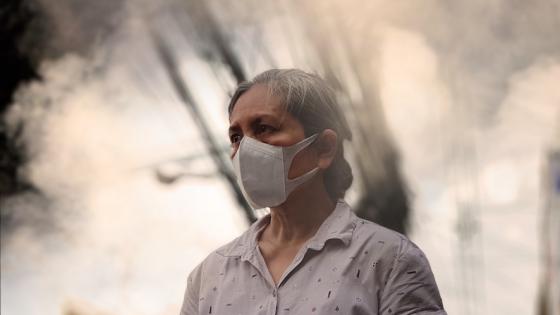Air pollution is a large health burden responsible for up to 4.5 million premature deaths per year worldwide (Cohen et al. 2017). In the US, air pollution is regulated primarily through the Clean Air Act (CAA). The recent 50th anniversary of the Act has sparked renewed interest in evaluating the effectiveness of this seminal piece of the regulation (Currie and Walker 2019, Aldy et al. 2022). While the CAA and its various amendments since 1970 span a multitude of regulatory measures, one key element has been the set of National Ambient Air Quality Standards (NAAQS) targeting specific ground-level pollutants including ozone (O3), sulphur dioxide (SO2), carbon monoxide (CO) and, most recently, fine particulate matter (PM2.5). The NAAQS operate through mandatory air quality improvement plans in non-attainment areas, which are those regions of the country where pollution exceeds predefined threshold levels. Most empirical research finds that, while air quality is improving across the US (Shapiro 2021), it improves more rapidly in non-attainment areas, a sign that the regulation is effective.
In a recent analysis of the latest NAAQS that target fine particulate matter (PM2.5) pollution and that took effect in 2005, we confirm that regulated areas indeed experienced more rapid air quality improvements (Sager and Singer, 2022). However, we also find that a simple before-and-after comparison of regulated (non-attainment) and unregulated (attainment) areas would attribute a significantly larger share of air quality improvements to the regulation than warranted. The reason can be seen in Figure 1, which plots air quality improvements on the vertical axis, measured as reductions in the annual average PM2.5 concentrations based on high-resolution satellite data in US census tracts over the five years following classification. The horizontal axis shows the so-called design values that the US Environmental Protection Agency (EPA) assigns to counties to determine whether they cross the regulatory threshold of 15 µgm−3, and which are calculated as the average of their PM2.5 readings in 2001–03 from the EPA’s ground monitoring network.
Figure 1 Air quality (PM2.5) improvements in attainment/non-attainment tracts
Notes: Each dot represents one Census tract in the US. The horizontal axis shows the EPA design values based on 2001-03 pollution monitor readings. All tracts with values above 15 were classified to be in non-attainment of the NAAQS for fine particulate matter (PM2.5) and subject to stricter regulation starting in 2005. The vertical axis shows the air quality improvements over the 5-year period ending in 2006-08 (positive values represent reductions in PM2.5 levels). Source: Sager and Singer (2022).
As can be seen in Figure 1, regulated tracts (in red) experienced larger improvements in air quality over the five-year period from 2001–2003 to 2006–2008. Simple before-and-after analysis – the technical term for this is a difference-in-differences estimation (DiD) – would attribute the entire difference between the average improvements in targeted regions (red dashed line on the right) and untargeted regions (blue dashed line on the left) to the regulation. This approach is indeed often used to quantify the air quality improvements induced by non-attainment designations. The problem here is that not all of the difference is necessarily driven by regulation. This can be seen when looking at the upward-sloping blue line, which indicates that average air quality improvements are larger in those regions that started with higher pollution levels even in the absence of regulation. In short, more polluted areas experienced faster air quality improvements even when they were not subject to the regulatory attention that comes with non-attainment designations. A simple before-and-after comparison would therefore overstate the air quality improvements that can be attributed to nonattainment designations.
We propose three approaches to account for this possible bias. We continue to find that non-attainment designations led to air quality improvements – PM2.5 levels fell by an additional 0.4µgm−3 over five years to be exact – but that the effect of regulation was substantially smaller than the popular before-and-after analysis would suggest. Why is this important? The first reason is that precise measurement of the air quality improvements that can be attributed to non-attainment designations are key to assessing the effectiveness of the regulation and for any comprehensive benefit-cost analysis. Our results suggest that the air quality benefits of the regulation are less than half the size when appropriately accounting for these time trends independent of regulation.
In addition, the degree to which Clean Air Act rules were effective in reducing pollution has important implications for environmental justice (Banzhaf et al. 2019, Drupp et al. 2021). Policymakers and researchers alike are increasingly aware of how pollution damages affect vulnerable populations (Deryugina et al. 2021, Graff Zivin et al. 2022). To take a specific example, previous research has documented that Black Americans tend to live in neighbourhoods with substantially higher PM2.5 levels (Jbaily et al. 2022) and that the air quality improvements triggered by CAA non-attainment designations contributed substantially towards narrowing that gap (Currie et al. 2020). If non-attainment designations were responsible for smaller air quality improvements than previously thought, they also contributed less to closing pollution exposure gaps, as we show in our work.
Finally, while addressing the above bias reduces the estimated effectiveness of the regulation, the estimated damages of air pollution may actually be magnified. This is because air quality improvements induced by non-attainment designations are often used to quantify the damages from air pollution. Previous work shows that pollution not only impairs health but also affects the long-run earnings potential of those exposed (Isen et al. 2014). One approach to counting the cost of air pollution is based on house prices, which tend to reflect homebuyers’ valuation of clean air. The idea of an instrumental variables approach is to link house prices solely to those changes in air quality that are driven by the regulation to avoid spurious relationships. This type of analysis has been essential to document the substantial economic cost of air pollution (Chay and Greenstone 2005, Bento et al. 2015). When a smaller portion of air quality improvements in those areas can be attributed to non-attainment designations, as we described above, pollution damage estimates change. Perhaps surprisingly, our work suggests that after properly accounting for any bias from time trends unrelated to regulation, the effect of PM2.5 levels on house prices is even larger than previously thought: we find that a 1% reduction in PM2.5 levels is associated with about a 1% increase in house prices.
Taken together, it appears that air pollution may be even more costly than previously thought, but that non-attainment designations under the Clean Air Act resulted in smaller, albeit still significant reductions in fine particulate matter pollution.
References
Aldy, J E, M Auffhammer and M Cropper (2022), “Looking back at 50 years of the Clean Air Act”, Journal of Economic Literature 60(1): 179-232.
Banzhaf, S, L Ma and C Timmins (2019), “Environmental justice: The economics of race, place, and pollution”, Journal of Economic Perspectives 33(1): 185–208.
Bento, A, M Freedman and C Lang (2015), “Who benefits from environmental regulation? Evidence from the clean air act amendments”, Review of Economics and Statistics 97(3): 610–622.
Chay, K Y and M Greenstone (2005), “Does air quality matter? evidence from the housing market”, Journal of Political Economy 113(2): 376–424.
Cohen, A, M Brauer, R Burnett, H Anderson, J Frostad, K Estep, K Balakrishnan, B Brunekreef, L Dandona, and R Dandona et al. (2017), “Estimates and 25-year trends of the global burden of disease attributable to ambient air pollution: an analysis of data from the Global Burden of Diseases Study 2015”, The Lancet 389(10082): 1907–1918.
Currie, J, J Voorheis and R Walker (2020), “What caused racial disparities in particulate exposure to fall? New evidence from the clean air act and satellite-based measures of air quality”, NBER Working Paper 24970.
Currie, J and R Walker (2019), “What do economists have to say about the clean air act 50 years after the establishment of the environmental protection agency?”, Journal of Economic Perspectives 33(4): 3–26.
Deryugina, T, N Miller, D Molitor and J Reif (2021), “Air pollution policy should focus on the most vulnerable people, not just the most polluted places”, VoxEU.org, 13 January.
Drupp, M A, U Kornek, J Meya and L Sager (2021), “Inequality and the environment: The economics of a two-headed Hydra”, CESifo Working Paper 9447.
Graff Zivin, J, M Neidell, N Sanders and G Singer (2022), “When externalities collide: influenza and pollution”, Grantham Research Institute on Climate Change and the Environment Working Paper 364, London School of Economics and Political Science.
Isen, A, M Rossin-Slater and R Walker (2014), “Every breath you take, every dollar you’ll make: The long-term consequences of the Clean Air Act of 1970”, VoxEU.org, 19 February.
Jbaily, A, X Zhou, J Liu, T-H Lee, L Kamareddine, S Verguet and F Dominici (2022), “Air pollution exposure disparities across US population and income groups”, Nature 601(7892): 228–233.
Sager, L and G Singer (2022), “Clean identification? The effects of the Clean Air Act on air pollution, exposure disparities and house prices”, Grantham Research Institute on Climate Change and the Environment Working Paper 376, London School of Economics and Political Science.
Shapiro, J (2021), “Pollution trends and US environmental policy: Lessons from the last half century”, VoxEU.org, 2 December.




